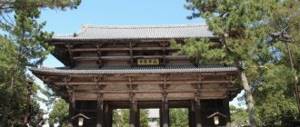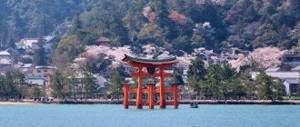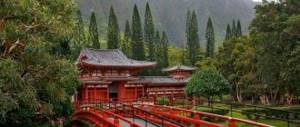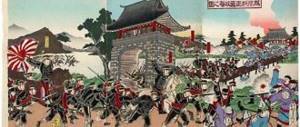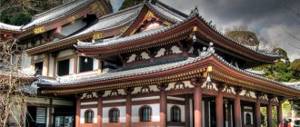| Administrative divisions of Japan |
| Prefectural level |
| Prefectures of Japan (都道府県to-do:-fu-ken ) |
| Lesser Level Units |
| Districts of Japan (支庁shicho:) Cities designated by government decrees (政令指定都市 seirei shitei toshi ) Counties (郡 gun ) |
| Municipal level |
| Central cities (中核市chu:kaku shi ) Special cities (特例市 tokurei shi ) Cities (市 shi ) Special areas of Tokyo (特別区 tokubetsu ku ) City districts (区 ku ) Towns (町 cho: / machi ) Villages (村 son / mura ) |
| Identification code of the subject of self-government |
| p • o • p |
Prefectures of Japan
— 47 administrative divisions of Japan at the highest level.
They are united in the todofuken
(Japanese: 都道府県
to-do:-fu-ken
).
According to this system, the country consists of 1 capital prefecture to
(Japanese 都) - Tokyo, 1
governorate to
(Japanese 道) - Hokkaido, 2
city prefectures fu
(Japanese 府) - Kyoto and Osaka - and 43
ken
prefectures (Japanese .県). For convenience, in Western Japanese studies it is customary to call the above-mentioned units “prefectures”.
Each prefecture is governed by a prefect (in the case of Hokkaido, a governor) and has its own legislative and administrative apparatus. For convenience, prefectures are often grouped into regions, which are not administrative units.
Prefectures are divided into smaller administrative units. These are Hokkaido districts, special cities designated by government decrees, and counties. The 14 districts exist only in Hokkaido Prefecture. For other prefectures, the unit of division is the county. Special cities, defined by government decrees, include cities whose population exceeds 500 thousand people. The capital Tokyo is not one of these cities, as it is an urban conglomerate and not a city.
The modern system of administrative division was introduced during the Meiji period in 1871, resulting in the abolition of the Han
and prefectures were created.
This event is called haihan chiken
(Japanese: 廃藩置県).
At the beginning, the number of prefectures corresponded to the number of hans
- over 300 units. Over time, they were reduced to 72, and in 1888 - to 47. The Law on Local Autonomy gave the prefectures more power. Finally, given the rapid development of urbanization in Japan, the Japanese government is considering a project to reform the prefectures into 10 large administrative units.
In addition to prefectures and counties, the country has administrative units at the municipal level that enjoy broad autonomy. These are the central cities of prefectures, special cities, cities proper, 23 special districts of Tokyo, as well as towns and villages.
History of prefecture types
Special prefectures include Tokyo, Kyoto, Osaka and Hokkaido. During the Edo period (1603–1867), the shogunate established 9 urban districts, which were governed by central officials (奉行支配地), and 302 district cities, which were governed by city officials (郡代支配地). With the advent of the Meiji era, 9 urban centers were turned into fu
, and 302 district cities are in
Ken
.
In 1871, after administrative reform, 3 urban fu
- Tokyo, Kyoto and Osaka.
In 1943, Tokyo Metropolitan Prefecture was renamed the capital to
(although no capital law was approved).
In the case of Hokkaido, circumstances were different. This island, which the Japanese called Ezoshima - "island of the Ainu" - was beyond the control of the shoguns. The exceptions were minor possessions of samurai families in the south of the island. In 1886 it received the name “Hokkaido”, which meant “northern sea route”. Its origin is related to the names of ancient Japanese paths before
(道), introduced in the 7th century.
by the Japanese imperial government. Since in the middle of the 19th century most of the island of Hokkaido was not developed by the Japanese, 14 Shicho
, unique centers of Japanese colonization, were established.
Background [edit]
| Administrative divisions of Japan |
| Prefecture |
| Prefectures |
| South of the prefecture |
|
| Municipal |
|
| Submunicipal |
|
|
The Western use of the word "prefecture" to refer to these Japanese regions stems from the fact that in the 16th century, Portuguese explorers and traders used the word "prefecture" to describe the fiefs they encountered there. [ citation needed
] Its original meaning in Portuguese, however, was closer to "municipality" than "province".
Today, in turn, Japan uses the word ken
(県), meaning "prefecture", to refer to Portuguese districts, while in Brazil the word "Prefeitura" is used to refer to city hall.
These fiefdoms were headed by a local warlord or family. Although fiefs had long since been dismantled, united and reorganized several times, and given legislative governance and oversight, the rough translation stuck.
The Meiji government established the current system in July 1871 with the abolition of the Han system and the establishment of the prefecture system (廃藩置県, haihan-chiken). Although there were initially over 300 prefectures, many of which were former han territories, this number was reduced to 72 in the second half of 1871 and to 47 in 1888. The Local Autonomy Law of 1947 gave the prefectures greater political power and established prefectures. governors and parliaments.
In 2003, Prime Minister Junichiro Koizumi proposed that the government consolidate the current prefectures into about 10 regional states (called dosusei
). The plan called for each region to have greater autonomy than the existing prefectures. This process will reduce the number of subprefecture administrative regions and reduce administrative costs. [3] The Japanese government also considered a plan to merge several groups of prefectures, creating a system of administrative divisions at the subnational level consisting of nine and 13 states, and giving these states more local autonomy than prefectures currently have. [4] As of August 2012, this plan has been abandoned.
List of prefectures
regions for convenience
(
regions
)
quietly:
(Japanese: 地方). These regions have developed historically; they do not have an administrative apparatus and are not administrative units. Below is a list of prefectures in ISO 3166-2:JP order, grouped by region.
| Map of Japan's prefectures(1) | |||||||
| : Incorrect or missing image (Clicking on the number or image of a prefecture will take you to the corresponding article.) | |||||||
| Hokkaido 1. Hokkaido[1] | Tohoku 2. Aomori 3. Iwate 4. Miyagi 5. Akita 6. Yamagata 7. Fukushima | Kanto 8. Ibaraki 9. Tochigi 10. Gunma 11. Saitama 12. Chiba 13. Tokyo 14. Kanagawa | Tube [2] 15. Niigata 16. Toyama 17. Ishikawa 18. Fukui 19. Yamanashi 20. Nagano 21. Gifu 22. Shizuoka 23. Aichi | Kansai 24. Mie 25. Shiga 26. Kyoto 27. Osaka 28. Hyogo 29. Nara 30. Wakayama | Chugoku 31. Tottori 32. Shimane 33. Okayama 34. Hiroshima 35. Yamaguchi | Shikoku 36. Tokushima 37. Kagawa 38. Ehime 39. Kochi | Kyushu and Okinawa 40. Fukuoka 41. Saga 42. Nagasaki 43. Kumamoto 44. Oita 45. Miyazaki 46. Kagoshima 47. Okinawa |
| (1) Islands that Japan disputes with Russia are colored orange. | |||||||
List of prefectures in alphabetical order:
| Prefecture | original name | Center |
| Island | Population (2000) | Area, km² | Density, people/km² | Counties | Municipalities | ISO |
| IT | 愛知県 | Nagoya | Tube | Honshu | 7 043 235 | 5 153,81 | 1 366 | 10 | 63 | JP-23 |
| Akita | 秋田県 | Akita | Tohoku | Honshu | 1 189 215 | 11 612,11 | 102 | 6 | 25 | JP-05 |
| Aomori | 青森県 | Aomori | Tohoku | Honshu | 1 475 635 | 9 606,26 | 154 | 8 | 40 | JP-02 |
| Wakayama | 和歌山県 | Wakayama | Kansai | Honshu | 1 069 839 | 4 725,55 | 226 | 6 | 30 | JP-30 |
| Gifu | 岐阜県 | Gifu | Tube | Honshu | 2 107 687 | 10 598,18 | 199 | 9 | 42 | JP-21 |
| Gumma | 群馬県 | Maebashi | Kanto | Honshu | 2 024 820 | 6 363,16 | 318 | 8 | 39 | JP-10 |
| Ibaraki | 茨城県 | Mito | Kanto | Honshu | 2 985 424 | 6 095,62 | 490 | 7 | 43 | JP-08 |
| Iwate | 岩手県 | Morioka | Tohoku | Honshu | 1 416 198 | 15 278,51 | 93 | 11 | 36 | JP-03 |
| Ishikawa | 石川県 | Kanazawa | Tube | Honshu | 1 180 935 | 4 185,32 | 282 | 6 | 19 | JP-17 |
| Kagawa | 香川県 | Takamatsu | Shikoku | Shikoku | 1 022 843 | 1 861,70 | 549 | 5 | 17 | JP-37 |
| Kagoshima | 鹿児島県 | Kagoshima | Kyushu | Kyushu | 1 786 214 | 9 132,42 | 196 | 11 | 49 | JP-46 |
| Kanagawa | 神奈川県 | Yokohama | Kanto | Honshu | 8 489 932 | 2 415,42 | 3 515 | 7 | 35 | JP-14 |
| Kyoto | 京都府 | Kyoto | Kansai | Honshu | 2 644 331 | 4 612,93 | 573 | 6 | 26 | JP-26 |
| Kochi | 高知県 | Kochi | Shikoku | Shikoku | 813 980 | 7 104,70 | 115 | 6 | 35 | JP-39 |
| Kumamoto | 熊本県 | Kumamoto | Kyushu | Kyushu | 1 859 451 | 6 908,45 | 269 | 10 | 48 | JP-43 |
| Mie | 三重県 | Kansai | Honshu | 1 857 365 | 5760,72 | 322 | 7 | 29 | JP-24 | |
| Miyagi | 宮城県 | Sendai | Tohoku | Honshu | 2 365 204 | 7 285,16 | 325 | 10 | 36 | JP-04 |
| Miyazaki | 宮崎県 | Miyazaki | Kyushu | Kyushu | 1 170 023 | 6 684,67 | 175 | 8 | 30 | JP-45 |
| Nagano | 長野県 | Nagano | Tube | Honshu | 2 214 409 | 12 598,48 | 163 | 14 | 81 | JP-20 |
| Nagasaki | 長崎県 | Nagasaki | Kyushu | Kyushu | 1 516 536 | 4 092,80 | 371 | 4 | 21 | JP-42 |
| Nara | 奈良県 | Nara | Kansai | Honshu | 1 442 862 | 3 691,09 | 391 | 7 | 39 | JP-29 |
| Niigata | 新潟県 | Niigata | Tube | Honshu | 2 475 724 | 12 582,37 | 197 | 10 | 35 | JP-15 |
| Oita | 大分県 | Oita | Kyushu | Kyushu | 1 221 128 | 5 804,24 | 210 | 3 | 18 | JP-44 |
| Okayama | 岡山県 | Okayama | Chugoku | Honshu | 1 950 656 | 7 008,63 | 278 | 10 | 27 | JP-33 |
| Okinawa | 沖縄県 | Naha | Kyushu | Ryukyu | 1 318 281 | 2 271,30 | 580 | 5 | 41 | JP-47 |
| Osaka | 大阪府 | Osaka | Kansai | Honshu | 8 804 806 | 1 893,18 | 4 652 | 5 | 43 | JP-27 |
| Saga | 佐賀県 | Saga | Kyushu | Kyushu | 876 664 | 2 439,23 | 359 | 6 | 20 | JP-41 |
| Saitama | 埼玉県 | Saitama | Kanto | Honshu | 6 938 004 | 3 767,09 | 1 827 | 9 | 70 | JP-11 |
| Whitefish | 滋賀県 | Otsu | Kansai | Honshu | 1 342 811 | 4 017,36 | 334 | 5 | 26 | JP-25 |
| Shizuoka | 静岡県 | Shizuoka | Tube | Honshu | 3 767 427 | 7 328,61 | 484 | 9 | 42 | JP-22 |
| Shimane | 島根県 | Matsue | Chugoku | Honshu | 761 499 | 6 707,32 | 114 | 7 | 21 | JP-32 |
| Chiba | 千葉県 | Chiba | Kanto | Honshu | 5 926 349 | 5 156,15 | 1 149 | 6 | 56 | JP-12 |
| Tokyo | 東京都 | Tokyo | Kanto | Honshu | 12 059 237 | 2 187,08 | 5 514 | 1 | 39 | JP-13 |
| Tokushima | 徳島県 | Tokushima | Shikoku | Shikoku | 823 997 | 4 145,26 | 199 | 8 | 24 | JP-36 |
| Tochigi | 栃木県 | Utsunomiya | Kanto | Honshu | 2 004 787 | 6 408,28 | 313 | 6 | 31 | JP-09 |
| Tottori | 鳥取県 | Tottori | Chugoku | Honshu | 613 229 | 3 507,19 | 175 | 5 | 19 | JP-31 |
| Toyama | 富山県 | Toyama | Tube | Honshu | 1 120 843 | 4 247,22 | 264 | 5 | 12 | JP-16 |
| Fukui | 福井県 | Fukui | Tube | Honshu | 828 960 | 4 188,76 | 198 | 7 | 17 | JP-18 |
| Fukuoka | 福岡県 | Fukuoka | Kyushu | Kyushu | 5 015 666 | 4 971,01 | 1 009 | 13 | 65 | JP-40 |
| Fukushima | 福島県 | Fukushima | Tohoku | Honshu | 2 126 998 | 13 782,54 | 154 | 13 | 61 | JP-07 |
| Hyogo | 兵庫県 | Kobe | Kansai | Honshu | 5 550 742 | 8 392,42 | 661 | 8 | 41 | JP-28 |
| Hiroshima | 広島県 | Hiroshima | Chugoku | Honshu | 2 878 949 | 8 476,95 | 340 | 5 | 23 | JP-34 |
| Hokkaido | 北海道 | Sapporo | Hokkaido | Hokkaido | 5 682 950 | 83 452,47 | 68 | 68 | 180 | JP-01 |
| Ehime | 愛媛県 | Matsuyama | Shikoku | Shikoku | 1 493 126 | 5 676,44 | 263 | 7 | 20 | JP-38 |
| Yamagata | 山形県 | Yamagata | Tohoku | Honshu | 1 244 040 | 9 323,34 | 133 | 8 | 35 | JP-06 |
| Yamaguchi | 山口県 | Yamaguchi | Chugoku | Honshu | 1 528 107 | 6 110,76 | 250 | 5 | 22 | JP-35 |
| Yamanashi | 山梨県 | coffee | Tube | Honshu | 888 170 | 4 465,37 | 199 | 5 | 28 | JP-19 |
See also[edit]
- List of prefectures in Japan by area
- List of prefectures in Japan by population
- List of prefectures in Japan by GDP
- List of prefectures in Japan by GDP per capita
- List of prefectures in Japan by Human Development Index
- List of prefectures in Japan by life expectancy
- List of prefectures in Japan by highest mountain
- List of prefectural capitals in Japan
- List of prefectural songs of Japan
- ISO 3166-2 codes for Japan
- List of prefectural governors in Japan
General[edit]
- List of regions of Japan
- Japanese government
Territorial disputes
See also: The problem of ownership of the southern Kuril Islands
There is an unresolved territorial dispute between Japan and Russia over the ownership of the southern Kuril Islands, which came under the control of Soviet troops in the last days of World War II and were included in 1946 by Decree of the Presidium of the Supreme Soviet of the USSR into the Khabarovsk Territory of the RSFSR, along with the other Kuril Islands and South Sakhalin[3 ]. The ownership of the islands Iturup, Kunashir, Shikotan and the Habomai island group is disputed by Japan. In Russia, the disputed territories are included in the Kuril and South Kuril urban districts of the Sakhalin region, in Japan they are included in the districts of Etorofu, Shikotan, Kunashiri, Syana and Shibetoro of the Nemuro district of the Hokkaido governorate.
Japan also disputes the ownership of the Liancourt Islands, controlled by the Republic of Korea.
The ownership of the Senkaku Islands, under Japanese control, is disputed by the People's Republic of China and the Republic of China.
Recommendations
- ^ a b
Nussbaum, Louis-Frédéric, 2002: "Provinces and prefectures" in
Encyclopedia of Japan
, item 780. - Prefectural code ( Fukensei
, ja:府県制), area code (
Gunsei
, ja:郡制), city code (
Shisei
, ja:市制), city and village code (
Chōsonsei
, ja:町村制) - Mabuchi, Masaru, "Municipal Incorporation in Japan", World Bank, 2001.
- " Dosusey
Regional System" Archived 2006-09-26 on the Wayback Machine National Association for the Advancement of Research. - Mochida, "Local Government Organization and Finance: Japan", in Shah, Anwar (2006). Local Governance in Industrial Countries
. The World Bank. - National Archives of Japan: 『明治東京全図』
- Tokyo Metropolitan Archives: 大東京 35区物語~15区から23区へ~東京23区の歴史
- The Japan Times, December 4, 2003: Little warmth to larger Tokyo gathering. Kanagawa chief pushes for creation of new administrative body to deal with regional issues
- Kanagawa Prefectural Government: 関東地方知事会
- Saitama Prefectural Government: 関東地方知事会
- "九都県市首脳会議." www.9tokenshi-syunoukaigi.jp
. - "ホーム - 関西広域連合."
- See ISO 3166
- Post-war changes in administrative division are not reflected in this table. The capital of the former Japanese administration is not necessarily the capital of the modern equivalent.
- Administered by the US Military Government in the Ryukyu Islands. Returned to Japan in 1972.
- Due to the division of Korea, Kogen (Gangwon/Gangwon), Keiki (Gyeonggi) and Kokai (Hwanghae) are divided between North and South Korea. While each Korea has its own Kangwon/Gangwon province, the North Korean part of Gyeonggi and the South Korean part of Hwanghae were absorbed into other provinces.
- Shunsaeng (Chuncheon) is located in modern South Korea.
- Submitted from the Qing Dynasty, later the Republic of China and Manchukuo.
- After World War II, the Soviet Union occupied this territory. The Soviet Union handed it over to the People's Republic of China in 1955.
- Mandate of the League of Nations
- Then administered by the Trust Territory of the Pacific Islands
Notes
- The southern part of Sakhalin Island and all the islands of the Kuril chain have been Japanese territory since 1907. At the end of World War II, they passed to the USSR and still remain under Russian jurisdiction. Japanese authorities consider the islands to be Japanese property.
- The Chubu region is divided into smaller subregions - Hokuriku, Kosintetsu, Tokai and Chukyu.
- Decree of the Presidium of the Supreme Soviet of the USSR On the formation of the South Sakhalin region as part of the Khabarovsk Territory of the RSFSR
To form the Yuzhno-Sakhalin region on the territory of Southern Sakhalin and the Kuril Islands with its center in the city of Toyohara and its inclusion in the Khabarovsk Territory of the RSFSR.
Chairman of the Presidium of the Supreme Council of the USSR M. Kalinin Secretary of the Presidium of the Supreme Council of the USSR A. Gorkin Moscow, Kremlin, February 2, 1946
Powers[edit]
Main article: Government of Japan § Local government
Japan is a unitary state. The central government delegates many functions (such as education and police) to prefectures and municipalities, but retains full control over them. Although local government spending accounts for 70 percent of total government spending, the central government controls local budgets, tax rates, and borrowing. [5]
The functions of the prefectural government include the organization of prefectural police, school supervision and maintenance of prefectural schools (mostly high schools), prefectural hospitals, prefectural roads, supervision of prefectural waterways, and regional urban planning. Their responsibilities include tasks delegated to them by the national government, such as maintaining most regular national roads (with the exception of certain major cities), and the prefectures coordinate and support their municipalities in their functions. De facto prefectures as well as municipalities were often less autonomous than the formal extent of local autonomy law suggests because
- most are heavily dependent on central government funding - a dependence that has recently been exacerbated in many regions by demographic transitions that are hitting rural areas harder/earlier as cities can partly offset this through rural migration, and
- In many policy areas, the basic framework is strictly established by national laws, and prefectures and municipalities are autonomous only within these frameworks.
Links
- Japan // Great Soviet Encyclopedia: [in 30 volumes] / ch. ed. A. M. Prokhorov. — 3rd ed. - M.: Soviet Encyclopedia, 1969-1978.
Prefectures Tohoku Akita · Aomori · Fukushima · Iwate · Miyagi · Yamagata Kanto Chiba · Gunma · Ibaraki · Kanagawa · Saitama · Tochigi · Tokyo Tube Aichi · Fukui · Gifu · Ishikawa · Nagano · Niigata · Shizuoka · Toyama · Yamanashi Kansai Hyogo · Kyoto · Mie · Nara · Osaka · Shiga · Wakayama Chugoku Hiroshima · Okayama · Shimane · Tottori · Yamaguchi Shikoku Ehime · Kagawa · Kochi · Tokushima Kyushu Kyushu: Fukuoka · Kagoshima · Kumamoto · Miyazaki · Nagasaki · Oita ·
Ryukyu Saga:
Okinawa
An excerpt characterizing the Prefectures of Japan
Throughout the boring day, during which Prince Andrei was occupied by the senior hosts and the most honorable of the guests, with whom the old count's house was full on the occasion of the approaching name day, Bolkonsky, looking several times at Natasha, who was laughing and having fun among the other young half of the company, kept asking himself: “What is she thinking about? Why is she so happy!” In the evening, left alone in a new place, he could not fall asleep for a long time. He read, then put out the candle and lit it again. It was hot in the room with the shutters closed from the inside. He was annoyed with this stupid old man (as he called Rostov), who detained him, assuring him that the necessary papers in the city had not yet been delivered, and he was annoyed with himself for staying. Prince Andrei stood up and went to the window to open it. As soon as he opened the shutters, moonlight, as if he had been on guard at the window for a long time waiting for it, rushed into the room. He opened the window. The night was fresh and still bright. Just in front of the window there was a row of trimmed trees, black on one side and silvery lit on the other. Under the trees there was some kind of lush, wet, curly vegetation with silvery leaves and stems here and there. Further behind the black trees there was some kind of roof shining with dew, to the right a large curly tree, with a bright white trunk and branches, and above it was an almost full moon in a bright, almost starless spring sky. Prince Andrei leaned his elbows on the window and his eyes stopped at this sky. Prince Andrei's room was on the middle floor; They also lived in the rooms above it and did not sleep. He heard a woman talking from above. “Just one more time,” said a female voice from above, which Prince Andrei now recognized. - When will you sleep? - answered another voice. - I won’t, I can’t sleep, what should I do! Well, the last time... Two female voices sang some kind of musical phrase that constituted the end of something. - Oh, how lovely! Well, now sleep, and that's the end. “You sleep, but I can’t,” answered the first voice approaching the window. She apparently leaned out of the window completely, because the rustling of her dress and even her breathing could be heard. Everything became quiet and petrified, like the moon and its light and shadows. Prince Andrei was also afraid to move, so as not to betray his involuntary presence. - Sonya! Sonya! – the first voice was heard again. - Well, how can you sleep! Look what a beauty it is! Oh, how lovely! “Wake up, Sonya,” she said almost with tears in her voice. - After all, such a lovely night has never, never happened. Sonya reluctantly answered something. - No, look what a moon it is!... Oh, how lovely! Come here. Darling, my dear, come here. Well, do you see? So I would squat down, like this, I would grab myself under the knees - tighter, as tight as possible - you have to strain. Like this! - Come on, you'll fall. There was a struggle and Sonya’s dissatisfied voice: “It’s two o’clock.” - Oh, you're just ruining everything for me. Well, go, go. Again everything fell silent, but Prince Andrei knew that she was still sitting here, he sometimes heard quiet movements, sometimes sighs. - Oh my god! My God! what is this! – she suddenly screamed. - Sleep like that! – and slammed the window. “And they don’t care about my existence!” thought Prince Andrei as he listened to her conversation, for some reason expecting and fearing that she would say something about him. - “And there she is again! And how on purpose!” he thought. In his soul suddenly arose such an unexpected confusion of young thoughts and hopes, contradicting his whole life, that he, feeling unable to understand his condition, immediately fell asleep. The next day, having said goodbye to only one count, without waiting for the ladies to leave, Prince Andrei went home. It was already the beginning of June when Prince Andrei, returning home, again drove into that birch grove in which this old, gnarled oak had struck him so strangely and memorably. The bells rang even more muffled in the forest than a month and a half ago; everything was full, shady and dense; and the young spruces, scattered throughout the forest, did not disturb the overall beauty and, imitating the general character, were tenderly green with fluffy young shoots. It was hot all day, a thunderstorm was gathering somewhere, but only a small cloud splashed on the dust of the road and on the succulent leaves. The left side of the forest was dark, in shadow; the right one, wet and glossy, glistened in the sun, slightly swaying in the wind. Everything was in bloom; the nightingales chattered and rolled, now close, now far away. “Yes, here, in this forest, there was this oak tree with which we agreed,” thought Prince Andrei. “Where is he,” Prince Andrei thought again, looking at the left side of the road and without knowing it, without recognizing him, he admired the oak tree that he was looking for. The old oak tree, completely transformed, spread out like a tent of lush, dark greenery, swayed slightly, swaying slightly in the rays of the evening sun. No gnarled fingers, no sores, no old mistrust and grief - nothing was visible. Juicy, young leaves broke through the tough, hundred-year-old bark without knots, so it was impossible to believe that this old man had produced them. “Yes, this is that same oak tree,” thought Prince Andrei, and suddenly an unreasonable, spring feeling of joy and renewal came over him. All the best moments of his life suddenly came back to him at the same time. And Austerlitz with the high sky, and the dead, reproachful face of his wife, and Pierre on the ferry, and the girl excited by the beauty of the night, and this night, and the moon - and all this suddenly came to his mind. “No, life is not over at the age of 31, Prince Andrei suddenly finally, permanently decided. Not only do I know everything that is in me, it is necessary for everyone to know it: both Pierre and this girl who wanted to fly into the sky, it is necessary for everyone to know me, so that my life does not go on for me alone So that they don’t live so independently of my life, so that it affects everyone and so that they all live with me!” Returning from his trip, Prince Andrei decided to go to St. Petersburg in the fall and came up with various reasons for this decision. A whole series of reasonable, logical arguments why he needed to go to St. Petersburg and even serve were ready at his service every minute. Even now he did not understand how he could ever doubt the need to take an active part in life, just as a month ago he did not understand how the thought of leaving the village could have occurred to him. It seemed clear to him that all his experiences in life would have been in vain and would have been meaningless if he had not applied them to action and taken an active part in life again. He did not even understand how, on the basis of the same poor reasonable arguments, it had previously been obvious that he would have humiliated himself if now, after his life lessons, he again believed in the possibility of being useful and in the possibility of happiness and love. Now my mind suggested something completely different. After this trip, Prince Andrei began to get bored in the village, his previous activities did not interest him, and often, sitting alone in his office, he got up, went to the mirror and looked at his face for a long time. Then he turned away and looked at the portrait of the deceased Lisa, who, with her curls whipped up a la grecque [in Greek], tenderly and cheerfully looked at him from the golden frame. She no longer spoke the same terrible words to her husband; she simply and cheerfully looked at him with curiosity. And Prince Andrei, clasping his hands back, walked around the room for a long time, now frowning, now smiling, reconsidering those unreasonable, inexpressible in words, secret as a crime thoughts associated with Pierre, with fame, with the girl on the window, with the oak tree, with female beauty and love that changed his whole life. And at these moments, when someone came to him, he was especially dry, strictly decisive and especially unpleasantly logical. “Mon cher, [My dear,],” Princess Marya would say when entering at such a moment, “Nikolushka can’t go for a walk today: it’s very cold.” “If it were warm,” Prince Andrei answered his sister especially dryly at such moments, “then he would go in just a shirt, but since it’s cold, we need to put warm clothes on him, which were invented for this purpose.” This is what follows from the fact that it’s cold, and not like staying at home when the child needs air,” he said with particular logic, as if punishing someone for all this secret, illogical inner work that was happening in him. Princess Marya thought in these cases about how this mental work dries out men. Prince Andrey arrived in St. Petersburg in August 1809. This was the time of the apogee of the glory of the young Speransky and the energy of the revolutions he carried out. In this very August, the sovereign, while riding in a carriage, fell out, injured his leg, and remained in Peterhof for three weeks, seeing daily and exclusively with Speransky. At this time, not only two so famous and alarming decrees were being prepared on the abolition of court ranks and on examinations for the ranks of collegiate assessors and state councilors, but also an entire state constitution, which was supposed to change the existing judicial, administrative and financial order of government of Russia from the state council to the volost board. Now those vague, liberal dreams with which Emperor Alexander ascended the throne were being realized and embodied, and which he sought to realize with the help of his assistants Chartorizhsky, Novosiltsev, Kochubey and Strogonov, whom he himself jokingly called comite du salut publique. [Committee of Public Safety.] Now everyone has been replaced by Speransky on the civil side and Arakcheev on the military side. Prince Andrei, soon after his arrival, as a chamberlain, came to the court and left. The Tsar, having met him twice, did not honor him with a single word. It always seemed to Prince Andrei that he was antipathetic to the sovereign, that the sovereign was unpleasant about his face and his whole being. In the dry, distant look with which the sovereign looked at him, Prince Andrei found confirmation of this assumption even more than before. The courtiers explained to Prince Andrey the sovereign's lack of attention to him by the fact that His Majesty was dissatisfied with the fact that Bolkonsky had not served since 1805. “I myself know how much we have no control over our likes and dislikes,” thought Prince Andrei, and therefore there is no need to think about personally presenting my note on the military regulations to the sovereign, but the matter will speak for itself.” He conveyed his note to the old field marshal, a friend of his father. The field marshal, having appointed an hour for him, received him kindly and promised to report to the sovereign. A few days later it was announced to Prince Andrey that he had to appear before the Minister of War, Count Arakcheev. At nine o'clock in the morning, on the appointed day, Prince Andrei appeared in the reception room of Count Arakcheev. Prince Andrei did not know Arakcheev personally and had never seen him, but everything he knew about him inspired him with little respect for this man. “He is the Minister of War, the confidant of the Emperor; no one should care about his personal properties; he was instructed to consider my note, therefore he alone can give it a go,” thought Prince Andrei, waiting among many important and unimportant persons in the reception room of Count Arakcheev. Prince Andrei, during his mostly adjutant service, saw a lot of adopted important persons and the different characters of these adopted ones were very clear to him. Count Arakcheev had a very special character in his reception room. A sense of shame and humility was written on the unimportant faces waiting in line for an audience in Count Arakcheev’s reception room; on the more official faces one common feeling of awkwardness was expressed, hidden under the guise of swagger and ridicule of oneself, one’s position and one’s expected face. Some walked thoughtfully back and forth, others laughed in whispers, and Prince Andrei heard the sobriquet [mocking nickname] of Andreich’s forces and the words: “uncle will ask,” referring to Count Arakcheev. One general (an important person), apparently offended that he had to wait so long, sat crossing his legs and smiling contemptuously at himself. But as soon as the door opened, all the faces instantly expressed only one thing - fear. Prince Andrei asked the duty officer to report about himself another time, but they looked at him with ridicule and said that his turn would come in due time. After several persons were brought in and out by the adjutant from the minister’s office, an officer was let in through the terrible door, striking Prince Andrei with his humiliated and frightened appearance. The officer's audience lasted a long time. Suddenly, peals of an unpleasant voice were heard from behind the door, and a pale officer, with trembling lips, came out of there, grabbed his head, and walked through the reception area. Following this, Prince Andrei was led to the door, and the attendant said in a whisper: “to the right, to the window.” Prince Andrei entered a modest, neat office and at the desk saw a forty-year-old man with a long waist, a long, short-cropped head and thick wrinkles, with frowning eyebrows over brown, dull green eyes and a drooping red nose. Arakcheev turned his head towards him, without looking at him. -What are you asking for? – asked Arakcheev. “I don’t... please, your Excellency,” said Prince Andrei quietly. Arakcheev's eyes turned to him. “Sit down,” said Arakcheev, “Prince Bolkonsky?” “I’m not asking for anything, but the Emperor deigned to forward the note I submitted to your Excellency...” “Please see, my dear, I read your note,” Arakcheev interrupted, only saying the first words affectionately, again without looking him in the face and becoming more and more depressed. and more in a grumpily contemptuous tone. – Are you proposing new military laws? There are many laws, and there is no one to enforce the old ones. Nowadays all laws are written; it is easier to write than to do. “I came by the will of the Emperor to find out from your Excellency what course you intend to give to the submitted note?” - Prince Andrey said politely. “I have added a resolution to your note and forwarded it to the committee.” “I don’t approve,” said Arakcheev, getting up and taking a paper from the desk. - Here! – he handed it to Prince Andrey. On the paper across it, in pencil, without capital letters, without spelling, without punctuation, was written: “unfoundedly composed as an imitation copied from the French military regulations and from the military article without the need of retreating.” – Which committee was the note sent to? - asked Prince Andrei. - To the committee on military regulations, and I submitted a proposal to enroll your honor as a member. Just no salary. Prince Andrei smiled. - I don’t want to. “Without a salary as a member,” Arakcheev repeated. - I have the honor. Hey, call me! Who else? - he shouted, bowing to Prince Andrei. While awaiting notification of his enrollment as a member of the committee, Prince Andrei renewed old acquaintances, especially with those persons who, he knew, were in force and could be needed by him. He now experienced in St. Petersburg a feeling similar to what he had experienced on the eve of the battle, when he was tormented by a restless curiosity and irresistibly drawn to higher spheres, to where the future was being prepared, on which the fate of millions depended. He felt from the embitterment of the old people, from the curiosity of the uninitiated, from the restraint of the initiated, from the haste and concern of everyone, from the countless number of committees, commissions, the existence of which he learned again every day, that now, in 1809, was being prepared here in St. Petersburg, some kind of huge civil battle, the commander-in-chief of which was a person unknown to him, mysterious and who seemed to him a genius - Speransky. And the most vaguely known matter of transformation, and Speransky, the main figure, began to interest him so passionately that the matter of military regulations very soon began to pass into a secondary place in his mind. Prince Andrei was in one of the most favorable positions to be well received into all the most diverse and highest circles of the then St. Petersburg society. The party of reformers cordially received and lured him, firstly because he had a reputation for intelligence and great reading, and secondly because by his release of the peasants he had already made himself a reputation as a liberal. The party of dissatisfied old men, just like their father’s son, turned to him for sympathy, condemning the reforms. Women's society, society, welcomed him cordially, because he was a groom, rich and noble, and almost a new face with the aura of a romantic story about his imaginary death and the tragic death of his wife. In addition, the general voice about him from everyone who knew him before was that he had changed a lot for the better in these five years, had softened and matured, that there was no former pretense, pride and mockery in him, and there was that calmness that purchased over the years. They started talking about him, they were interested in him and everyone wanted to see him.




